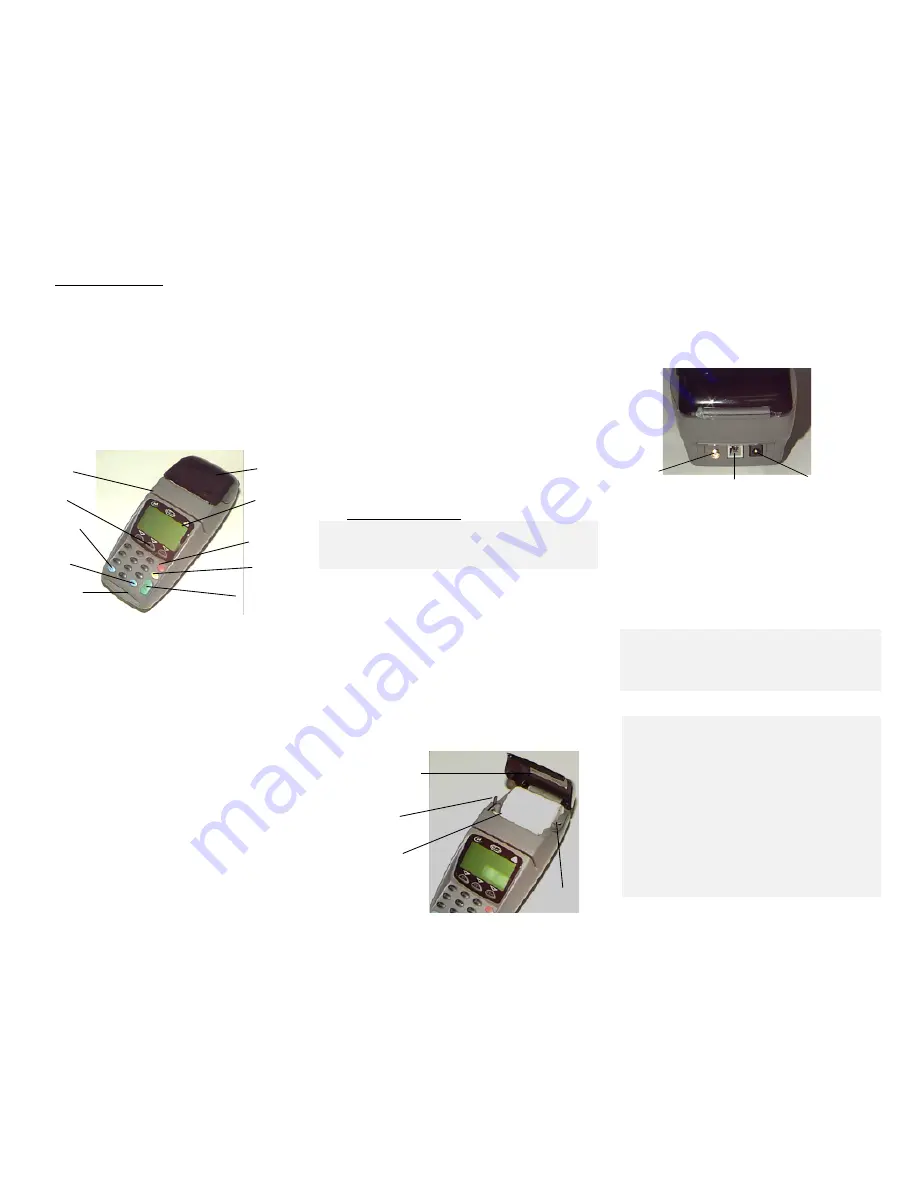
1.
Terminal description:
1.1 Introduction:
The Elite 780RF is a fully self-contained RF EFTPOS
terminal with an integrated printer and the functionality
to process all smart card, debit and credit purchases. The
terminal communicates with the bank using the RF data
network. This network is similar to that used for mobile
phones except that it is for data only. The terminal
features a secure, multi-application operating system,
which allows a number of different applications to run
on the terminal independently, without jeopardizing
software security.
Paper Feed
Key
Functions keys
Magnetic Stripe
Card Reader
Printer
Compartment
CAN key
CORR key
ENTER key
ADMIN key
LCD Display
Smart
Card Reader
1.2 The Terminal:
The Elite 780RF terminal has the following peripherals:
1.2.1 Display:
Standard 4 line x 16 character LCD graphic display, with
back lighting.
1.2.2 Keypad:
•
18 keys, with back lighting, with the following
special function keys:
•
F1, F2, and F3 keys: Programmable keys which
permit access to terminal level functions and the
system menu.
•
Paper Feed key: Performs a 20mm paper feed.
•
ENTER key: is used to confirm the data entered or
displayed.
•
CAN key: is used to cancel the current function and
return the terminal to the idle state.
•
CORR key: is used to correct any invalid data entry.
•
ADMIN key: is used to access the terminal
administration function menu.
1.2.3 Magnetic Stripe Card Reader:
This is a bi-directional reader capable of simultaneously
reading Tracks 1&2, and is located just above the display.
1.2.4 Modem:
The Modem facilitates data exchange over an RF network.
1.2.5 Printer:
The built-in printer is a high-speed thermal printer (4 lines
per second) and is graphics compatible.
1.2.6
Smart Card Reader:
Complies with standard ISO 7816, Sync & Async.
1.3 Package contents are as follows:
1. The Elite 780RF terminal.
2. RF antenna.
3. Wall mount power adapter for charging the NiCd
battery.
4. Thermal printer paper, one roll.
5. Installation guide.
2.
Installation procedure:
A
Important Note:
The battery must be charged for 24
hours before using the terminal for any purpose
including key injection, program loading or customer
use.
(See Paragraph 2.3)
2.1 Paper loading (If required):
1. Open the paper compartment cover.
2. Move the paper load lever forward to disengage the
friction roller.
3. Remove the empty paper roll by pressing the roll release
lever on the right hand side.
4. Position the paper roll with the end of the roll protruding
from UNDERNEATH the roll.
5. Feed the paper under the printer’s roller until it protrudes
from the top of the printer.
6. Fit the paper roll to the spindle and move the paper load
lever back to engage the friction roller.
7.
Close the cover and test the operation of the printer by
pressing Paper Feed key.
Paper Load
Lever
Metal blade to
tear off paper
Roll Release
Lever
Printer
Compartment
cover
2.2 Connecting the RF antenna:
1. Place the RF antenna connector over the coaxial
screw mount located on the back panel. Make sure
the wire within the connector fits into the small hole
in the coaxial mount.
2. Tighten the connector by turning the antenna
attachment clockwise.
RS232 Port
DC Power Jack
Coaxial RF antenna
screw mount
2.3
Battery charging procedure:
2.3.1 At Installation:
1. After unpacking it is important to provide an initial
charge. This conditioning cycle is required for the
battery pack to reach full capacity quickly.
2. Connect the terminal to AC power using the
supplied power pack designed for this terminal. You
will know the terminal is receiving AC power when
the display stays on continuously. The terminal
must be charged continuously for 24 hours.
A
Make sure that you use the correct AC power adapter
supplied with the terminal. Many adapters can appear
similar and will plug into the terminal but will not
work properly causing erratic behavior, poor charging
or even damage to the unit
.
2.3.2 Normal use:
A
1.
After a full charge the Terminal in normal usage is
expected to provide 50 or more transactions before
a recharge is required. Slow printing usually
indicates the battery is low.
2. This terminal has a “reserve” capability in the event
that more transactions are occasionally needed. As
long as the print time is acceptable the Terminal
will provide additional transactions beyond normal.
The effect will be continued slowdown of the
printer as well as a longer recharge cycle.
3. In normal use the
charge time is 12 hours. After
extended use the terminal will require additional
charge time, not exceeding 24 hours.
4. If the terminal has been inactive a number
of
weeks
it may require another 24 hour initial charge.


